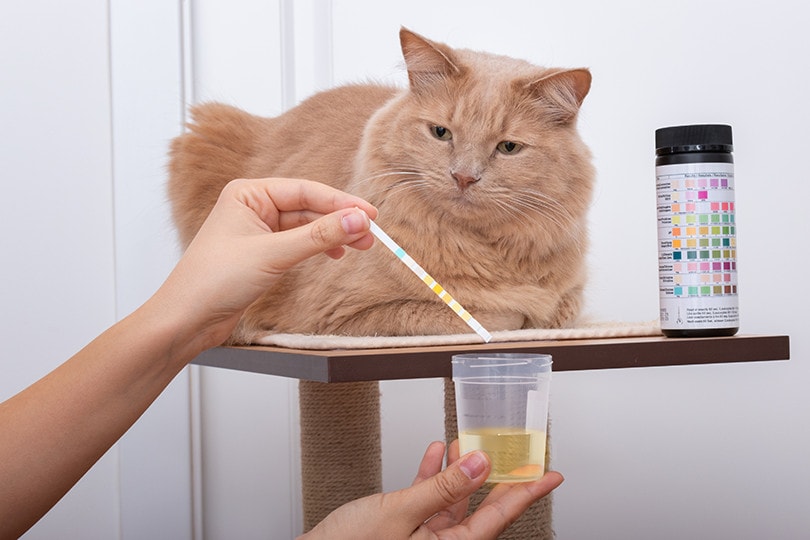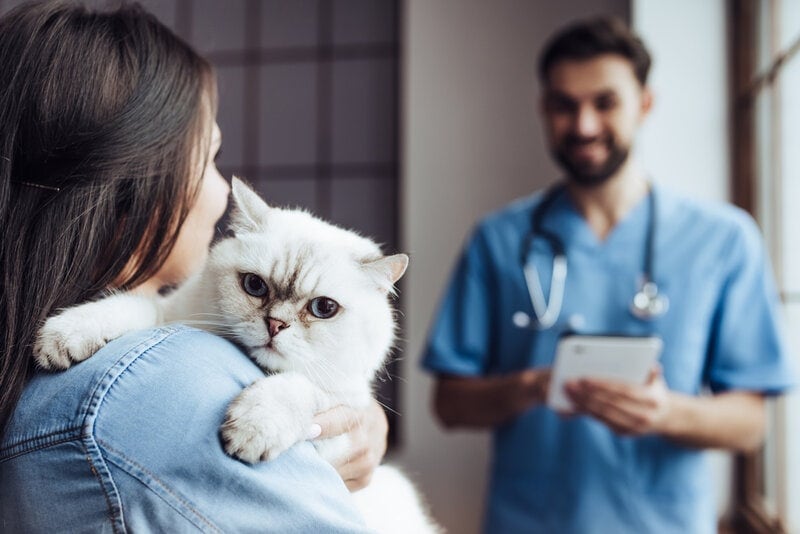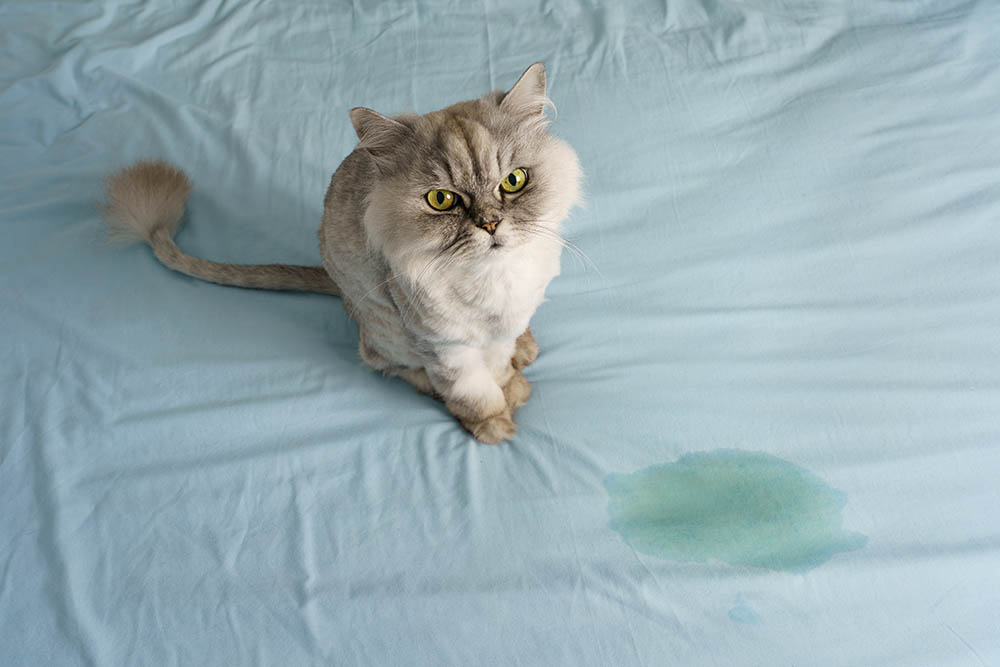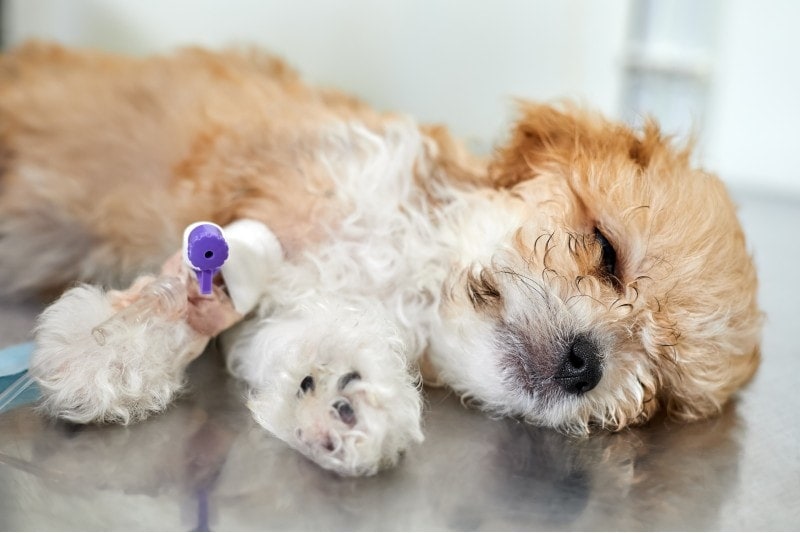How Do Vets Get Urine Samples From Cats? Our Vet Explains

Updated on

Click to Skip Ahead
How do vets collect a urine sample in a veterinary clinic?
When is the best time to collect a urine sample from my cat?
Is Cystocentesis painful for cats?
How long can a cat hold its pee?
How long can you keep a cat’s urine sample before testing?
What tests can be performed on a cat’s urine?
Vets use a variety of tests to try and work out what is wrong with our feline friends when they are sick. Urinalysis is a series of tests that are performed on a urine sample that gives a wealth of information about your cat’s health. Urine tests help vets screen for specific diseases, manage illnesses, and monitor response to treatment. But it’s not easy to ask our feline friends to pee in a pot, so how do vets get a urine sample from a cat?
How to Collect a Urine Sample From Your Cat at Home
A urine sample collected from your cat at home is referred to as a “free catch” sample, which means the urine is collected into a clean container after it has left your cat’s body. There are some limitations to free catch samples; for example, if a bacterial culture or protein measurement is needed, then this may not always be the optimal way to analyze your cat’s urine.
Fear not, as collecting a urine sample from your feline friend should be an easy and stress-free procedure following the guide below. No fancy equipment is required, just a clean litter tray, non-absorbent cat litter, and a pipette to collect the sample.
- Empty, clean, and thoroughly dry your cat’s litter tray. This is important as dirt, chemicals, and even water can contaminate the urine sample
- Fill the base of the litter tray with a non-absorbent cat litter; ideally, one that is designed for collecting urine samples
- Put the litter tray back in its normal place. You may need to keep your cat confined indoors, or in one room of your house until they have used the litter tray. However, if they become distressed by this then let them out to resume their normal routine.
- When your cat has passed urine, put on some gloves and tip the tray to pool the urine in one corner. Use a pipette to suck up the urine sample and carefully place it in a clean, sealed container.
- Label your cat’s sample with their name and the date and time of collection
- Get the urine sample to your vet. The sooner the urine is analyzed, the better. However, if this is not possible right away, then store the sample in the fridge until it can be tested.
There are several types of non-absorbent cat litter available to buy, your vet will likely be able to supply a suitable product for urine collection.
How Do Vets Collect a Urine Sample in a Veterinary Clinic?
An alternative to a ‘free-catch’ sample is called a cystocentesis. This involves collecting a urine sample directly from the bladder and is performed by a veterinary surgeon in practice. A very small needle is guided into the urinary bladder either by feeling the bladder or by using an ultrasound machine to visualize the bladder. It may sound scary, but it is very similar to having a blood sample taken from the vein.
The procedure takes a few seconds to perform, and cats generally don’t find this procedure painful or stressful. Most cats tolerate this procedure well when they are awake, and there is no pain or bruising afterward. For cats that get stressed by being handled or being in an unusual environment such as a veterinary practice, the procedure can be performed under light sedation.

When Is the Best Time to Collect a Urine Sample From My Cat?
At home, it is best to try and get a urine sample from your cat when his or her bladder is full. Keeping your cat indoors overnight, or locking the cat flap, might mean it is easier to collect a sample in the morning. Vets will often request a urine sample around the same time as a blood sample as this helps with interpreting certain blood parameters.
Is Cystocentesis Painful for Cats?
No, a cystocentesis is normally very well tolerated by cats and is no more painful or stressful than having a blood sample taken. A small amount of urine (5-10 ml) is taken for analysis and cats can resume their normal routine straight away.
How Long Can a Cat Hold Its Pee?
Typically, as soon as you are tasked with collecting a urine sample from your feline friend, they will seemingly hold it in all day! Anyone with a lazy moggy knows that cats can turn sleeping into an Olympic sport. It is not unusual for cats to go 24-48 hours without bothering to venture outside or to the litter tray to urinate. Most cats can hold their pee overnight. However, cats should have access to a clean litter box, or free access to the outside if they choose to urinate outdoors, at all times. Not being able to urinate when they need to is very stressful for cats and can lead to urinary problems.

How Long Can You Keep a Cat’s Urine Sample Before Testing?
The fresher the urine sample, the better! A urine sample that is collected and tested straight away is often more reliable than a urine sample that has been stored for some time. However, it depends on the type of test being performed on the urine.
If you collect a urine sample at home from your cat, try to get it to your vet as soon as possible for analysis. If you are unable to get it to the practice within 4 hours, then it can be stored in the fridge for up to 24 hours. If the sample has been in the fridge, be sure to let your veterinary practice know, as this can affect some results; for example, urine crystals often start to form in urine that has been chilled in as little as 12 hours.
What Tests Can Be Performed on a Cat’s Urine?
Urine tests can be used to help diagnose many different conditions such as bladder infections, stress cystitis, kidney disease, bladder stones, and diabetes. Many urine tests can be done quickly in a veterinary practice such as measuring the concentration of the urine to screen for kidney disease, testing the urine for glucose which can indicate diabetes, and looking at the urine under the microscope to look for blood, inflammatory cells, or bacteria, which can indicate a bladder infection. Urine samples may need to be sent to an external laboratory for other tests, such as a bacterial culture or protein measurement.
Conclusion
If you are struggling to collect a urine sample from your cat at home, contact your veterinary practice for help as they will be able to offer alternative options.
Featured Image Credit: Yaya Photos, Shutterstock













